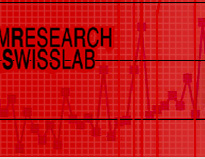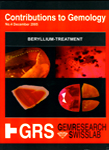The
Beryllium-Treatment of Natural Fancy Sapphires with
a New Heat-Treatment Technique Part A
By
Dr. A. Peretti, FGG, FGA, EurGeol
GRS Gemresearch Swisslab AG, Lucerne, Switzerland
and Prof. Dr. D. Günther
Institute of Chemistry, Swiss Federal Institute of
Technology (SFIT), Zurich, Switzerland
(Reprinted
with corrections from Contributions to Gemology, No.1,
2002)
INTRODUCTION
Sapphires and rubies
of different colors are routinely heat-treated to
produce products of better clarity and color. As long
as the treatment does not involve diffusion of color
influencing trace elements - such as Ti, Fe and Cr
- into the gemstones surface or irradiation, the trade
generally accepts the enhanced gem materials as being
highly valuable, depending on size, rarity and beauty.
In mid 2001, sapphires and rubies treated with a new
method appeared on the market with dominantly orange-pink
colors, which are commonly known in the trade as the
"Padparadscha" colors.
Natural Padparadschas
are among the world's most requested, and rarest,
gemstones, and therefore highly-priced. Depending
on the exact nature of this new enhancement process,
and hence the wording used to disclose and supply
these sapphires to the market, the price of these
materials may vary considerably. Early Internet published
reports initiated a worldwide controversy on the nature
of the treatment, ranging from pure heat treatment
to a full blown diffusion treatment. The uncertainty
about the exact nature of the treatment method, and
therefore the lack of investor confidence, caused
the worldwide market for the new sapphire materials
to collapse (February - March 2002). Of particular
interest to the trade is the question: "Are these
new materials diffusion-treated?"
This is based on earlier
reports of the presence of Beryllium in these sapphires,
and the occasional presence of color zoning confined
to the sapphires' facets (See Internet References
found in Lit. 01). A key factor to understand the
color giving mechanism is the use of special analytical
methods, such as UV-VIS-NIR (origin of color analyses),
ED-XRF (e.g. Iron (Fe), Chromium (Cr) and Titanium
(Ti) trace element analyses), SEM-EDS (chemical analyses
of contaminated substances at the gemstones' surface),
visual and spectroscopic cathodoluminescence investigations
(analyses of internal growth structures), color-stability
measurements (long-term color-stability to UV and
visible light), and, most importantly, Laser Ablation
Inductively Coupled Plasma Mass Spectrometry (LA-ICP-MS).
The LA-ICP-MS method - used to characterize the content
and variation of all trace elements, including light
elements such as Lithium (Li), Boron (B) and Beryllium
(Be) on a micro scale - turned out to be the key factor
in understanding the new heat treatment technique.
This report contributes to the understanding of the
new heat treatment with Beryllium and to differentiate
from conventional heat-enhancement (E) and conventional
surface diffusion treatment (T).
|
|
MATERIALS
The majority of the
tested material included natural fancy sapphires from
Tanzania and Madagascar (both enhanced and unenhanced),
as well as other comparison materials (described below).
The entire collection of materials (320 reference
samples) is the property of one of the authors' companies
(GRS Gemresearch Swisslab AG (Switzerland) and GRS
(Thailand) Co. LTD, and is stored in the companies'
reference collections.
The sapphire material
can be divided into the following groups:
a.) Unheated (N).
b.) Conventional heat-treated (E).
c.) Conventional diffusion-treated (T).
d.) Synthetic (Syn) and Irradiated (IR).
e.) Beryllium-Treatment, short noted as H(Be).(*)
f.) Beryllium-Treatment, Chantaburi Dec 2001, Table
A6, Part A. H(Be)
g.) With conventional heat treatment and the additional
new heat treatment method, Chantaburi Dec 2001 to
Jan 2002, Table A6, Part A. Tested before and after
Beryllium-Treatment.
h.) Unheated and conventional heat-treated gemstones,
with additional Beryllium-Treatment, Bangkok, Feb
2002, Table A6, Part B. Samples tested before and
after treatment with Beryllium.
Details
a.) GRS acquired 120
rough (pre-polished) fancy sapphires (unheated) of
different colors (including "Padparadscha"
sapphires) between 1999 and 2002 from K.V. Gems Co.,
Ltd. (Bangkok), AJS GEMS LTD. (Bangkok), GMR (Gem
Mining Resources, Madagascar), and from Bangkok and
Chantaburi open markets in Thailand. The material
from Madagascar revealed inclusions typical of the
Illakaka mining area (clusters of small zircons).
This study also includes untreated Songea sapphires
from the GRS collection (acquired in 1996)
b.) For the purpose of comparison with heat-treated
natural sapphires from previous years, 30 further
heat-treated yellow sapphire samples - as well as
"Padparadscha" colors - were investigated.
c.) For further comparison with diffusion-treated
samples, eight diffusion-treated blue sapphires were
available, including three samples acquired in 1996
(in Tucson, USA) and five samples acquired in 2002
in Bangkok. These samples from Bangkok were sold as
surface diffusion-treated (the element used for diffusion
was declared as titanium, and the diffused basic corundum
was declared as originally being a natural white sapphire).
d.) More than 50 synthetic corundum samples and 15
irradiated synthetic samples were available for comparison.
e.) Commercially representative products of this new
treatment included faceted natural orangy-pink and
orange and yellow sapphires (origin Madagascar). They
were obtained from three different companies: In November
2001 from K.V. Gems Co. LTD (Thailand), and in December
2001 from 2 other companies in Bangkok. This study
also includes samples of African origin (Tanzania),
samples obtained in February 2002, and 12 faceted
orange-red to vivid orangy-red sapphires, produced
by the new treatment in Chantaburi in December 2001.
|








